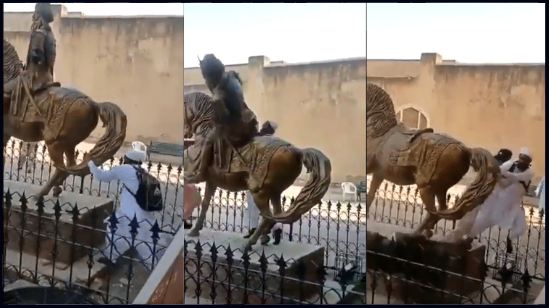The statue of Maharaja Ranjit Singh, the Sikh ruler popularly known as Sher-e-Punjab, has been vandalized in Lahore. A fanatic with a bag on his back and skullcap can be seen vandalizing the statue in a video posted by Union minister Hardeep Singh Puri.
“Vandalism in Lahore of the statue of Maharaja Ranjit Singh Ji, the great unifier of India, has to be strongly condemned. This act which attempts to erase the shared history of the subcontinent shows how extremist ideologies feel emboldened in our volatile neighbourhood,” tweeted Puri.
Vandalism in Lahore of the statue of Maharaja Ranjit Singh Ji, the great unifier of India, has to be strongly condemned. This act which attempts to erase the shared history of the subcontinent shows how extremist ideologies feel emboldened in our volatile neighbourhood. pic.twitter.com/aI2wN3QGbe
— Hardeep Singh Puri (मोदी का परिवार) (@HardeepSPuri) August 17, 2021
Reacting to the incident, Ministry of External Affairs spokesperson, Arindam Bagchi, in a statement, said, “We have seen disturbing reports in the media about the vandalization of the statue of Maharaja Ranjit Singh in Lahore today. This is the third such incident wherein the statue has been vandalised, since it was unveiled in 2019.”
“Such attacks on the cultural heritage of minority communities in Pakistan highlight the growing intolerance and lack of respect for minority communities in Pakistani society.” Bagchi further said that “incidents of violence against minority communities, including attacks on their places of worship, their cultural heritage, as well as their private property, are increasing at an alarming rate” and mentioned that “it was only 12 days ago that a mob attacked and desecrated a Hindu temple in Rahim Yar Khan in Pakistan”.
“The Pakistani state has completely failed in its duty to prevent such attacks. This is creating a climate of fear for the minority communities to practice their faith. We call upon the Government of Pakistan to ensure the safety, security and well-being of its minority communities,” Bagchi said.
The statue, which was unveiled by the Lahore fort administration in 2019, has been vandalized two times before this incident. The fort administration beefed up the security after the last two attacks, but as everyone knows, fanatics rule the roost in Pakistan, and this became evident once again with these attacks.
In the last few years, the Imran Khan government has tried to reach out to Sikhs through appeasement moves. On November 28, 2018, a few months after Khan became Prime Minister, the Kartarpur Corridor was inaugurated by Pakistan’s PM Imran Khan. The 4-km long corridor connects Kartarpur, the final resting place of Sri Guru Nanak Sahib, to the Gurdaspur district of Punjab, India.
After that, the statue of Maharaja Ranjit Singh was inaugurated in collaboration between Bobby Singh Bansal, from the UK, and the Walled City of Lahore Authority. “The project was meant to commemorate the 180th death anniversary of Maharaja Ranjit Singh and to forge a lasting friendship amongst the people of Punjab,” Bobby Singh Bansal had said.
So, the Pakistani government made two big moves – obviously for political and strategic gains – to appease Indian Sikhs, and some opportunistic people like Navjot Singh Sidhu fell for that. But, given the kind of fanatic people that reside in Pakistan, any respect for other religions is very unlikely.
The statue was vandalized in August 2019, then in last year, and now. In just two years, it has been vandalized by people who identify themselves with one or other conservative Islamic groups that come out of Madrassas of Pakistan.
The people who identify themselves as leaders of the Sikh community like Sidhu, and the Khalistani elements from the Sikh community, have maintained silence over the issue so far. Khalistanis and Islamists are known to be in bed with each other.
During the anti-CAA protests and the farmers’ protest, some members of the Sikh community sided with the Islamists, often inviting them to the Gurudwaras to recite the prayers, served them biryanis and gave mind-numbingly tepid slogans like Sikh-Muslim unity.
Ever since then, the Khalistanis who have dominated the space, often masquerading as protestors have toed the line of the Islamists. After all, a big chunk of funding for Khalistanis comes straight from Pakistan and its notorious terrorist elements.































